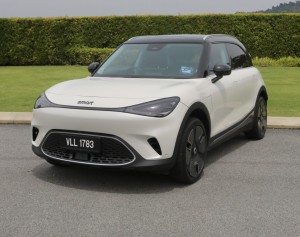Nio’s mass market push draws scorn as EV maker promises a profit
By BLOOMBERG | 27 December 2024
SHANGHAI: It’s a wonder three little headlights can stir up such debate. But that’s what many netizens in China have been driven to comment on following the launch of Nio Inc.’s newest sub-brand, Firefly.
The electric hatchback was unveiled last weekend at Nio’s annual gathering for its customers, partners and media.
The compact car will start from 148,800 yuan (RM92,000) and features a rather plain design punctuated by three little round lights at the front and rear, which look more cutesy than chic.
Nio watchers were quick to point out the resemblance to the Honda e and its symmetrical "eye-like" LED headlights, which most said look a lot better.
Many derided the car, saying it undermines Nio’s premium eponymous brand and the automaker’s positioning of itself as a luxury marque.
(Also over the weekend Nio showcased its most expensive car ever, the ET9, a four-seater sedan meant to take on Porsche’s Panamera series or Mercedes-Benz’s luxury S range.)
But for Nio, passing its 10-year anniversary and yet to turn a profit, heading down into the mass market to ramp up sales volumes may be the most sensible way forward.
Once regarded as one of China’s brightest electric vehicle stars, Nio has had several near-death experiences.
The first came in 2019 after heavy spending on marketing and splashy showrooms failed to generate demand for its ES8 and ES6 electric sport utility vehicles, and the municipal government of Hefei stepped in with a US$1 billion rescue package.
Prospects improved in 2021, when Nio recorded some its highest-ever gross margins, but by 2023, Nio was struggling financially again.
In July of that year, Abu Dhabi-backed fund CYVN Holdings invested US$738.5 million and later acquired shares in Nio from an affiliate of Tencent for US$350 million.
In December 2023, CYVN committed to invest a further US$2.2 billion in return for a 20.1% stake.
According to Nio CEO William Li, the automaker has fallen short of its own expectations for three consecutive years and is now at least two years behind schedule.
At home, BYD is a much bigger threat than it was a decade ago while Nio’s overseas expansion plans have encountered a number of setbacks, including, in Europe, tariffs on Chinese EV imports and a slower-than-expected build out of its battery-swap stations.
External factors, including lithium price hikes and Covid lockdown disruptions, have added to the challenge.
Fronting a media scrum earlier this month in Shanghai, Li was peppered with more than 200 questions and was at pains to assure the public.
"We survived five years since 2019, and now with a healthy operating cash flow, we can for sure survive longer than another five, don’t worry,” he said.
That may be easier said than done.
Several Chinese EV brands, including WM Motor, have bowed out due to cut-throat competition domestically, leaving car owners in limbo when it comes to after-sales and maintenance.
The most recent is Jiyue, a joint venture backed by giant Baidu Inc. and well-established Chinese player Geely automobile Holdings Ltd.
Shortly after it displayed a new vehicle at the Guangzhou auto show in November and started taking pre-order deposits of 50,000 yuan (RM31,000), management abruptly cut staff, sparking employee complaints and a customer panic.
Nio also needs to spend money to make money, risking the 42.2 billion yuan (RM26bil) it had in cash and cash equivalents as of Sept 30.
Research and development into advanced driving semiconductors is a must, Li has said, calling that a "reasonable business decision” considering the procurement costs from Nvidia Corp alone this year.
Longer term, it will improve Nio’s gross margin and reduce supply chain risks, Li reasons.
Another thing Nio didn’t address as it launches new brands is, beyond price and specs, how they’re that different and the potential cannibalisation between them.
Will Firefly owners, who may pay as little as 100,000 yuan (RM62,000) under a battery-leasing model, be allowed into the clubby Nio Houses, for example, the upmarket social spaces reserved for Nio car owners around the world?
Without those perks that, at least for Nio’s core customer base, are an important draw, it’s uncertain whether the new brands (there’s also Onvo) can translate into higher sales volumes.
Nio is well behind larger rivals in China - its deliveries totalled almost 191,000 units for the first 11 months of 2024, versus around 1.6 million for BYD’s pure electric cars.
Nio is projecting to double sales in 2025 to at least 440,000 units, with Firefly adding "several thousand” deliveries per month, according to Li.
That’s still comparatively tiny but Li is bullish, maintaining that "profitability in 2026 is baseline” the EV maker "can’t afford to miss.”
Tags
Autos Nio
Reviews

7.9
Xpeng G6 580 Pro: Fresh and fluidic

Guangzhou adventures: Zontes 368 scooter and 703 Adventure m...

Zontes motorcycle factory in Jiangmen: Running on a fast tra...

7.6
Maserati GranTurismo (Mk2) Modena: Sharp and smooth operator

6.8
Triumph Tiger 900 GT Pro: Multi-talented adventurer

Hyundai Ioniq 5 N: Born rascal

6.6
Husqvarna Svartpilen 401: Inspiring retro design

8.8
smart #1 (Premium): Agile, engaging, roomy, premium motoring
Videos

StarCarSifu Editors' Choice Awards 2024: Top winners

The Snowball – Lamborghini’s Heartwarming Christmas Story of...

EVOGO battery swapping solution showcased at IAA Mobility 20...
